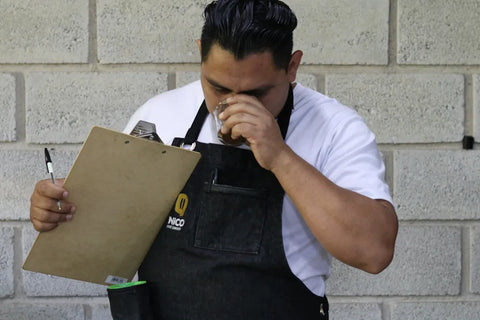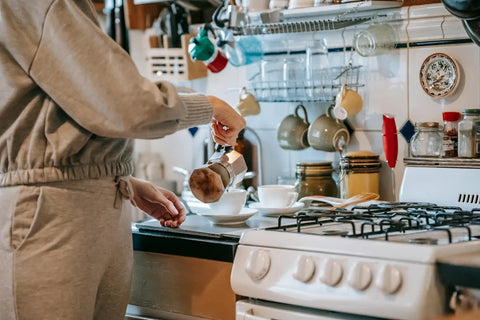Coffee Grind Type Demystified: How to Brew the Perfect Cup

Are you tired of your morning cup of coffee ending up too bitter or too weak?
The secret to a perfect cup of coffee lies in the grind type. But with so many options available, it can be overwhelming to know which one to choose.
Fear not, because in this article, we will demystify the different coffee grind types and guide you on how to brew the perfect cup every time.
Whether you prefer a French press, espresso, or pour-over, understanding the right grind size is crucial for extracting the full flavor potential of your beans.
CONTENT
Why Coffee Grind Size Matters
The grind size of your coffee beans plays a vital role in the extraction process and ultimately affects the taste and strength of your brew.
When you grind coffee beans, you expose a larger surface area, allowing water to extract the flavors and oils more efficiently.
However, different brewing methods require different grind sizes to achieve the desired outcome.
A finer grind will result in a stronger, more intense flavor, while a coarser grind will produce a milder, less concentrated brew.
Understanding the impact of grind size will empower you to control the taste and strength of your coffee, ensuring a consistently satisfying cup every time.
The size of the coffee grind is important because it determines the rate at which water flows through the coffee during brewing.
A finer grind will slow down the extraction process, while a coarser grind will speed it up.
The Type of filter of your Coffee Machine
Each coffee maker has an aspect that defines the final result of your cup of coffee, the filter.
There are multiple filter materials and each can affect the coffee extraction. Typically you will find filters are made from:
- Paper
- Metal
- Fabric
- Plastic

For example, for paper filters, the thickness of the paper and its porosity determine the amount of oil and sediment from the coffee that will seep through the filter and end up in your cup.
Metal coffee filters come with varying hole sizes, ranging from small to large. The size of the holes affects the body and flavor of your coffee.
A finer grind is necessary for smaller holes, resulting in a bolder flavor, while larger holes require a coarser grind, resulting in a lighter feel in your mouth.
Based on these factors that may not have been previously considered, we will use an analogy to clarify how they impact the taste of your coffee.
The Jars Analogy
Imagine three glass jars:
- One filled with sand
- Another one filled with marbles
- A last one filled with rocks

If we were to pour water into all the jars and measure the time it takes for the water to reach the bottom, which jar would reach the bottom first?
Correct, this is not a complex concept. In a jar containing rocks, the water will reach the bottom first.
Now, imagine the same thing when you make a pour-over or a drip coffee; if you grind the coffee too coarse when the water hits the coffee, it will go through it so fast and through the filter in such a short time that the water-coffee contact will be minimum.
You will have a watered down coffee as a result.
Now, for baristas or coffee enthusiasts, it is common knowledge that a pour-over typically takes around 3-4 minutes to prepare.
If the water is poured too quickly and the process is completed in 1-2 minutes, this indicates a sub-extraction.
In such cases, the coffee's minimum attributes may not have been fully extracted, resulting in a less flavorful cup.
No worries if you're not a professional barista! We want you to enjoy your coffee to the fullest with the equipment you have at home.
To ensure the best results, it's essential to choose the right grind for your machine.
We've got you covered with a helpful table below to guide you.

Different Types of Coffee Grinders
Before we delve into the various grind types, let's explore the different types of coffee grinders available. There are two main types: blade grinders and burr grinders.
Blade grinders, as the name suggests, use spinning blades to grind the coffee beans.
They are typically more affordable but may result in an inconsistent grind size due to the uneven chopping motion of the blades.
This inconsistency can negatively impact the flavor and extraction of your coffee.
On the other hand, burr grinders offer a more precise and consistent grind size. They operate by crushing the beans between two burrs, resulting in a more uniform grind.
Burr grinders are available in both manual and electric options, with the latter offering additional features such as adjustable grind settings.

Investing in a quality burr grinder will significantly improve the consistency and control over your grind size, leading to a better brewing experience and superior coffee flavor.
There are conical and flat burr grinders, we recommend the latter.
Coarse Grind: Best for French Press and Cold Brew
The coarse grind is characterized by large, chunky particles that resemble sea salt or breadcrumbs.
This grind size is ideal for brewing methods such as French press and cold brew, where a longer steeping time is required.
The French press method involves immersing the coffee grounds in water for several minutes before pressing down a plunger to separate the liquid from the grounds.
The coarse grind allows for a slow extraction process, resulting in a full-bodied and rich cup of coffee with some sediment.
Cold brew, on the other hand, involves steeping coffee grounds in cold water for an extended period, usually overnight.
The coarse grind allows for a slow extraction, resulting in a smooth, low-acid coffee concentrate that can be diluted with water or milk.
Grind your coffee beans to a coarse consistency, resembling coarse kosher salt. And Enjoy your rich and flavorful cup of coffee.
Medium Grind: Ideal for Drip Coffee Makers and Pour-Over
The medium grind falls between the coarse and fine grind sizes, resembling granulated sugar or sand.
This grind is well-suited for drip coffee makers and pour-over methods, where a balanced extraction is desired.
Drip coffee makers are one of the most common brewing methods, found in households and offices worldwide.
These machines rely on gravity to drip hot water over a bed of coffee grounds, extracting flavors as the water passes through.
Grind your coffee beans to a medium consistency, similar to sand. Add the grounds to the filter basket of your drip coffee maker and pour the desired amount of water into the reservoir.
Start the brewing process and allow the machine to work its magic. The result will be a well-balanced cup of coffee with a medium body and flavor.
Pour-over brewing, on the other hand, involves manually pouring hot water over coffee grounds placed in a filter.
This method allows for precise control over brewing, resulting in a clean and flavorful cup of coffee.
Start by measuring your coffee and water ratios to brew the perfect pour-over coffee. A good starting point is a ratio of 1:16, where one part coffee is brewed with 16 parts water. Adjust the ratio according to your taste preferences.
Grind your coffee beans to a medium consistency, resembling granulated sugar. Allow the coffee to drip into your cup, maintaining the water level and avoiding overflow.
The result will be a clean, flavorful, and aromatic cup of coffee.
Fine Grind: Perfect for Espresso Machines
The fine grind is characterized by small, powdery particles that resemble table salt or powdered sugar.
This grind size is essential for brewing espresso, which requires a high-pressure extraction method.
Espresso machines force hot water through tightly packed coffee grounds, producing a concentrated shot of coffee with a silky crema on top.
To achieve optimal flavors and extraction, a fine grind is necessary to slow down the water flow and increase the contact time between the water and coffee.
To brew the perfect espresso shot, check our espresso calibration guide. The result will be a small, concentrated shot of intense coffee with a layer of crema on top.
Extra Fine Grind: Used for Turkish Coffee
Turkish coffee is a traditional brewing method that originated in the Middle East and is known for its strong flavor and unique preparation.
This method requires an extra fine grind to achieve the desired results.
Turkish coffee involves boiling finely ground coffee beans in a special pot called a cezve.
The coffee is typically served unfiltered, allowing the grounds to settle at the bottom of the cup.
Grind your coffee beans to an extra fine consistency, resembling powdered sugar or flour.
Turkish coffee is typically enjoyed with a glass of water and a sweet treat to balance its strong flavor.
Tips for Grinding Coffee Beans at Home
Grinding coffee beans at home is an excellent way to ensure freshness and control over your grind size. Here are some tips to help you achieve the best results:
- Invest in a quality burr grinder: Burr grinders offer more consistent and precise grind sizes compared to blade grinders. Consider investing in a burr grinder to elevate your coffee brewing experience.
- Grind coffee just before brewing: Coffee beans start losing their flavor and aroma shortly after grinding. To maximize the freshness of your brew, grind your coffee beans just before you're ready to brew.
- Use the right grind setting: Adjust the grind setting on your grinder according to your brewing method. Refer to the guidelines mentioned earlier to determine the appropriate grind size for your desired brew.
- Grind in small batches: Avoid grinding large quantities of coffee at once, as this can lead to stale coffee. Grind only what you need for immediate brewing to maintain freshness.
- Practice consistency: Consistency is key when grinding coffee beans. Aim for an even grind size throughout to ensure a uniform extraction and consistent flavor.
By following these tips and practicing your grinding technique, you'll be able to enjoy the freshest and most flavorful cup of coffee every time.

Final Thoughts
Choosing the right grind type is an essential step towards brewing the perfect cup of coffee.
Understanding which grind size works best for your preferred brewing method is crucial for extracting the full flavor potential of your beans.
Investing in a quality burr grinder will provide you with precise control over your grind size, leading to a more consistent and enjoyable brewing experience.
Remember to adjust the grind size according to your taste preferences and experiment with different ratios to find your perfect cup of coffee.
So, the next time you reach for your coffee beans, take a moment to consider the grind size and let it guide you towards unlocking a rich, aromatic cup of perfection.
Keep reading:
How Can I make my coffee less bitter?
Discover the Flavors of Oaxaca: Exploring Coffee & Culinary Delights of Mexico
Latest Coffee Blog Posts

Our Coffee-Filled Adventure at Coffee Fest Orlando 2025
Coffee Fest Orlando 2025 brought together coffee lovers, roasters, and café owners for an unforge...
Read more →
Is there a sommelier for coffee?
Ever heard of a Q-grader? Often called a coffee sommelier, these certified professionals are the ...
Read more →
Which Coffee Roast Works Best with Your Machine?
The coffee roast you choose can make or break your brew. Learn which roast level pairs best with ...
Read more →